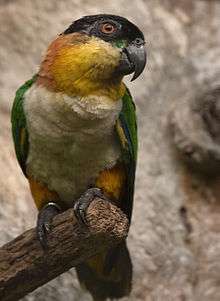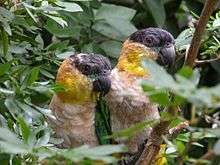Black-headed parrot
| Black-headed parrot | |
|---|---|
 | |
| At Jurong Bird Park, Singapore | |
| Scientific classification | |
| Kingdom: | Animalia |
| Phylum: | Chordata |
| Class: | Aves |
| Order: | Psittaciformes |
| Family: | Psittacidae |
| Genus: | Pionites |
| Species: | P. melanocephalus |
| Binomial name | |
| Pionites melanocephalus (Linnaeus, 1758) | |
| Synonyms | |
|
Pionites melanocephala | |
The black-headed parrot (Pionites melanocephalus ; sometimes incorrectly Pionites melanocephala), also known as the black-headed caique, black-capped parrot or pallid parrot (for P. m. pallidus), is one of the two species in the genus Pionites of the family Psittacidae; the other species being the allopatric white-bellied parrot.
It is found in forest (especially, but not exclusively, humid) and nearby wooded habitats in the Amazon north of the Amazon River and west of the Ucayali River in Brazil, northern Bolivia, Colombia, Ecuador, French Guiana, Guyana, Peru, Suriname, and Venezuela. It is generally fairly common and occurs in many protected areas throughout its range.
It is most often found in pairs or small noisy flocks of up to 10 individuals, but sometimes up to 30. In the wild, they eat mostly flowers, pulp, and seeds and possibly insects.

Description
The black-headed parrot is a medium-small, short-tailed parrot with a black crown, yellow to orange head, whitish belly, yellow thighs and crissum (the area around the cloaca), green back, wings and upper tail, blue primaries (blackish from below), and greyish-black bill and feet. The white breast feathers of wild caiques are often stained a chestnut brown (or 'isobel') colour. This may be tannin staining, as result of their particular affinity for bathing by rubbing their bodies against wet leaves and other plant matter.[2]
Male and female birds have identical plumage.
3.jpg) |
_-side.jpg) |
_-back.jpg) |

Subspecies
There are two subspecies of the black-headed parrot. They hybridize freely and individuals showing some level of intermediacy in color are common:
- P. m. melanocephalus: Eastern part of its range. Orange thighs and crissum, nape deep orange, and belly white.
- P. m. pallidus: Western part of its range. Yellow thighs and crissum, nape relatively pale, and belly tinged yellowish (often barely visible; belly normally appears "dirty white" in the wild).
Juveniles of both subspecies are strongly tinged yellow below.
Aviculture
Black-headed parrots are popular in aviculture. The only ways to determine gender of an individual black-headed parrot are surgical sexing and DNA sexing. DNA sexing is safer for the bird than surgical sexing.
Black-headed parrots are energetic pets. They need a large cage with lots of toys and perches (they tend to hop more than fly). Cage minimum should be 24" L X 24" W X 36" H, though the larger the better. Maximum bar spacing is 1".
The black-headed parrot can have a tendency to bite, so owners may need to set boundaries early on. However, potential owners should prepare for a bird that uses its beak more often than other parrot species.
Black-headed parrots poorly mimic human speech. They will mimic other surrounding sounds, such as alarm clocks, smoke detectors, microwave-oven beeps, laughs, car alarms, and whistles. In addition, caiques will combine sounds they have picked up to make new ones.
References
- ↑ BirdLife International (2012). "Pionites melanocephalus". IUCN Red List of Threatened Species. Version 2013.2. International Union for Conservation of Nature. Retrieved 26 November 2013.
- ↑ McMichael, John. "Color". The Caique Site. Retrieved 3 February 2014.
- Collar, N. (1997). Pionites melanocephala (Black-capped Parrot). pp. 457 in: del Hoyo, J., Elliott, A., & Sargatal, J. eds (1997). Handbook of the Birds of the World. Vol. 4. Sangrouse to Cuckoos. Lynx Edicions, Barcelona. ISBN 84-87334-22-9
- Parr, M., & Juniper, T. (1998). A Guide to the Parrots of the World. Pica Press, East Sussex. ISBN 1-873403-40-2
- Restall, R., Rodner, C., & Lentino, M. (2006). Birds of Northern South America. Vol. 1 & 2. Helm, London. ISBN 0-7136-7242-0 (vol. 1); ISBN 0-7136-7243-9 (vol. 2)
- Ridgely, R., & Greenfield, P. (2001). The Birds of Ecuador - Field Guide. Cornell University Press. ISBN 0-8014-8721-8
- Schulenberg, T., Stotz, D. Lane, D., O'Neill, J, & Parker, T. (2007). Birds of Peru. Helm, London. ISBN 978-0-7136-8673-9
- Sigrist, T. (2006). Aves do Brasil - Uma Visão Artistica. ISBN 85-905074-1-6
External links
| Wikimedia Commons has media related to Pionites melanocephalus. |
- World Parrot Trust Parrot Encyclopedia - Species Profile
